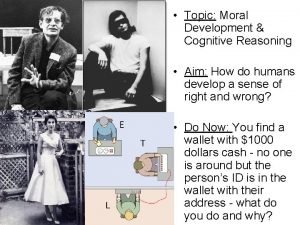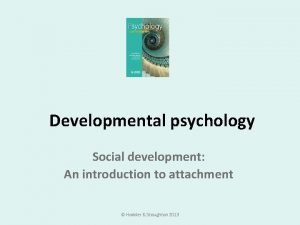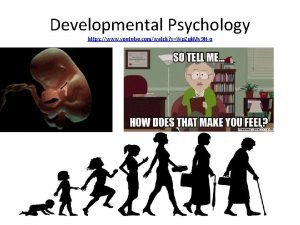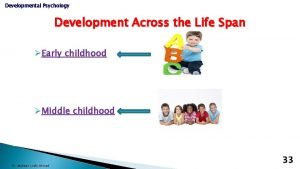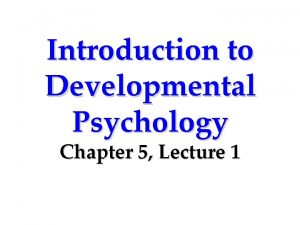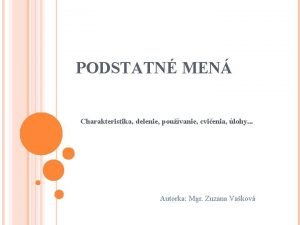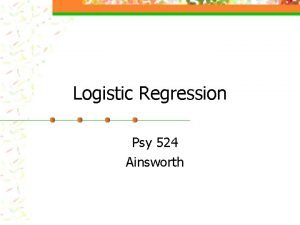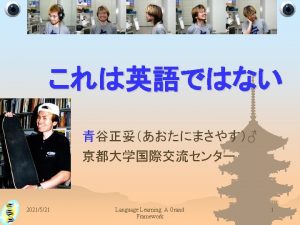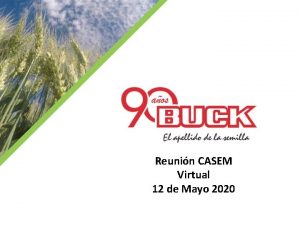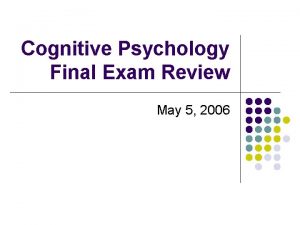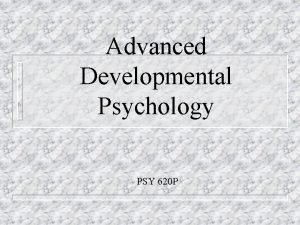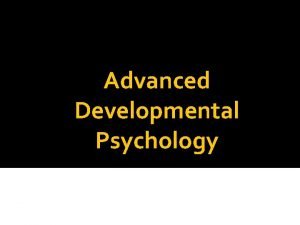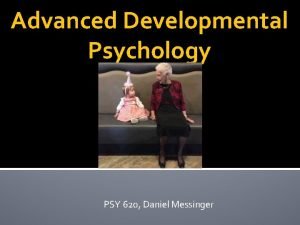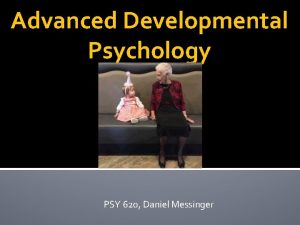Advanced Developmental Psychology PSY 620 P Example exam























































- Slides: 55

Advanced Developmental Psychology PSY 620 P

Example exam question �Nomi et al. describe decreasing MSSD over the lifespan for a large set of brain areas and networks, increasing MSSD for areas of insula and VTC, and quadratic effects for thalamus and VTC. Design a study which rectifies any sampling issues with Nomi et al, and expands Nomi et al by including a specific measure of behavior. What analyses would be employed to increase understanding of neural and cognitive flexibility?

Cultural Psychology Babies African interaction (describe first 45 s)– https: //www. youtube. com/watch? v=v. B 36 k 0 h. Gx. DM Scenes from Africa location (trailer style 4: 50) https: //www. youtube. com/watch? v=Lp. LHu. E 2 Fymg Full movie Babies– https: //play. google. com/movies#z. Soyz

Individual development is how cultures continue

Efe infants have multiple, simultaneous relationships � Influenced by physical, social ecological, cultural factors � sense of self incorporating other people Not initially focused on one person that progresses to other relationships. ▪ Tronick, E. Z. , Morelli, G. A. , & Ivey, P. K. (1992). The Efe forager infant and toddler's pattern of social relationships: Multiple and simultaneous.

What about Bronfenbrenner? The cultural veto

Overview � Efe and the cultural veto Cross-cultural (comparative) psychology Problems in context � Cultural (embedded) psychology VS Guatemalan toddlers ▪ Toys and learning � Presentations Tsimane reduced language input Language intervention in rural Senegal � � Synthesis of cross-cultural and cultural psychology? African caregiving (Otto et al. ) Smile divergence (Wormann et al. ) Discontinuities Japan

Cross-cultural research: Goals and methods � Culture as an independent variable that ‘acts on’ people � Previously developed and standardized research methods are applied to various cultures (e. g. , Piagetian tasks, Strange Situation)

Cross-cultural research: Problems with interpretation � Understanding of language and concepts applied � Relevance and applicability of measure to daily living and survival in different cultures � Cannot easily account for heterogeneity within cultures; therefore cannot isolate causal associations (e. g. , which tools matter? )

Cross-Cultural Patterns of Attachment

Cognitive Development Piaget’s concrete operational stage

Piaget’s Conservation Tasks

https: //www. psychologytoday. com/articles/20120 3/pt-puzzle-card-logic

Role of context

Cultural categorization �We presented three subjects (1 -3) with drawings of an ax, a saw, and a hammer and asked, “Would you say these things are tools? ” �All three subjects answered yes. “What about a log? ” 1: “It also belongs with these. We make all sorts of things out of logs - handles, doors, and the handles of tools. ” 2: “We say a log is a tool because it works with tools to make things. The pieces of logs go into making tools. ” https: //www. marxists. org/archive/luria/work s/1979/mind/ch 04. htm

Cultural Psychology (Cole, 1996) � Culture does not act on people but instead is the “medium of human life” � An individual is fully embedded within his/her culture � Measurement must be based on locally derived procedures

Cultural Psychology �All social and emotional development occurs in a cultural context �Culture involves shared beliefs and practices which unite communities and differentiate them from other communities �What may appear to be a universal feature of development, is often one of myriad, cultural solutions to a problem

Provide some examples �What to do when baby cries �Where should baby sleep �Who should play with baby �Who should take care of baby �What about rambunctious toddlers

Privileged Treatment of Toddlers: Cultural Aspects of Individual Choice and Responsibility. � The study: 16 Mayan families from San Pedro, Guatemala 16 middle class families from Salt Lake City, Utah Interactions between toddlers (14 to 20 mo) and siblings (3 to 5 yrs) Interview with mother about child-rearing, social behavior, etc. Given 9 objects to toddlers and siblings to manipulate, with mother’s help Christine Mosier and Barbara Rogoff (2003) Nayfeld

Proportions of Events Regarding Access to an Object Event Salt Lake City. 59 (. 20) San Pedro. 87 (. 09) Mothers endorsed toddler’s privileged position . 43 (. 24) . 63 (. 22) Mothers endorsed toddler’s nonprivileged position . 25 (. 13) . 04 (. 05) Siblings endorsed toddler’s privileged position . 45 (. 19) . 80 (. 09) Siblings endorsed toddler’s nonprivileged position . 54 (. 21) . 19 (. 09) Toddlers eventually gained access to the object Nayfeld Christine Mosier and Barbara Rogoff (2003)

Guatemalan Mayan mothers � “almost never overruled their toddlers' objections to or insistence on an activity—they attempted to persuade but did not force the child to cooperate toddlers were not compelled to stop hitting others. � [Toddler] hitting was not regarded as motivated by an intent to harm because they were expected to be too young to understand the consequences of their acts for other people. ” Mosier & Rogoff, 2003

Attention to Interactions Directed to Others �Cultural variation in children’s attentiveness Indigenous vs. westernized learning styles �Guatemalan Mayan & European American �Pueblo basic vs. Mexican high school Maternal education level and cultural traditions �Toy construction paradigm Bustamante Correa-Chavez & Rogoff, 2009

Kids’ Attention to Interactions Directed to Others Bustamante Correa-Chavez & Rogoff, 2009


Aims How frequently & From whom ▪ Do children aged 0 -11 years receive on one verbal input among Tsimane forager-horticulturalists of lowland Bolivia? To better understand potential cross-cultural variability in linguistic experiences of children Lopez

Background literature: language development � Adult verbal input (quality and quantity of child-directed speech) shapes children's language development “A child has more opportunities to hear the forms of words in a meaningful social context, which may facilitate learning of word-to-meaning pairings” (Hoff & Naigles, 2002) “Less directed input during early childhood…may result [in] not only lower levels of explicit knowledge (e. g. smaller vocabularies) but also less efficient speech processing” (Weisleder & Fernald, 2013) Lopez

Put in Context Environmental factors’ (e. g. SES) influence verbal skills (receptive or productive vocab size and speed of word recognition) Hart & Risley (1995) argue that this effect can be traced back to the verbal input between birth and 3 years ▪ Professional parents’ children heard three times as many words than peers in homes of parents on welfare � Studies controlling for SES also find this effect of child-directed speech � Studies find child-directed speech is more effective in verbal engagement and lexical development than overheard speech Particularly when uttered in one-on-one conversations With adults rather than children � Lopez

Caveat to understanding language development HOWEVER— Most evidence on early language development comes from small populations— “Western, educated, industrialized, rich and democratic” � Why does that matter? Preindustrial populations have larger families Live in smaller family-based clusters, sharing spaces ▪ Resulting in regular contact with extended family which may increase number and diversity of conversational partners & ▪ Decrease number of one on one conversations � � Lopez

Research with child-directed speech in preindustrial societies � Preindustrial children hear less directed speech at early ages � Overall differences of talkativeness across cultures � Cross-cultural differences disappear around 33 months (2. 75 years old) [when looking at proportion of directed speech) Lopez

Research with child-directed speech in preindustrial societies � � Sentences uttered around children (Shneidman, 2010) 13 month olds Mayan children ▪ 60% from other children ▪ 31% from mother ▪ 9% from other adults ▪ 90% of the sentences come from children by age 3 � 14 month olds American children ▪ 8% by other children ▪ 79% from mother ▪ 13% from other adults ▪ 10% of the sentences come from children by age 3 Lopez

Present study Tsimane forager horticulturalists of lowland Bolivia Contains 90 villages (between 50 -550 individuals within each) Villages have extended family clusters (each 3 -4 households) Native Tsimane language used, Spanish when speaking to non-natives – merchants) Mothers provide 80% of direct child care in the first 6 months, 70% in first 6 years � Observational technique to systematically monitor behavior (not just verbal) � Looked at residential clusters from 6 villages 43, 903 direct observations of individuals aged 0 -85 years Recorded in 2 -3 hour blocks Between 7 am-7 pm Single observer (advanced anthro students—Ph. D or honors thesis) Every 30 min coded up to 2 concurrent activities of all individuals � Lopez

Lopez

LOPEZ

LOPEZ

Conclusions � Infants and young children were engaged in one-on-one verbal interactions less than older individuals � The amount of child-directed speech increased with child’s age with directed and non-directed speech equaling out around 8 -11 years old � The actors who engaged in child-directed speech varied as a function of the child’s age LOPEZ

Comparisons with previous work LOPEZ

Comparisons with previous work LOPEZ

Potential factors accounting for cultural variation � SES � Community � Income � Living situation � Parental education LOPEZ

Discussion � Are there other language development mechanisms that should be considered in conjunction with this study? � Does language use and need vary culturally? How do we consider the results with this in mind? � What does language development entail? Non-verbal communications? � Does the limited input affect outcomes of language acquisition? What does it mean if it does/does not? � Is language acquisition the end goal of studying language input? LOPEZ

Westwright

Background � Children who hear more rich and varied speech from caregivers have better language outcomes � Most research conducted in Western countries � In many non-Western, low- income, subsistence cultures, talking to babies is less common and in some cases discouraged Westwright

Intervention and Hypotheses �Intervention designed by a NGO (Tostan) in rural Senegal and evaluated by independent researchers �Primary aim: Increase caregiver’s verbal engagement with their children �Hypotheses: 1. Caregivers who participated in the program would have improvements in verbal engagement and knowledge of child development 2. Children of program participants would show greater language improvements relative to children who did not receive the program Westwright

Participants and Setting � 43 group sessions and bimonthly home visits over 9 -10 months for children age 0 -6 � 12 program and 12 comparison (wait list) Wolof-speaking villages � Content included infant brain development, role of parenting practices, discussion of traditional parenting practices � Measures: Structured play session videos All-day audio recording of speech Parent knowledge questionnaires Westwright

Results – Caregiver Outcomes � Program and comparison villages comparable on most measures at baseline � Program caregivers increased speech to their child by 78% (no change in comparison caregiver speech) � Program caregivers had greater improvements in knowledge of child development relative to comparison caregivers Westwright

Results – Child Outcomes � 32% increase in utterances relative to control � Greater gains in language milestones and expressive vocabulary � Small, non-significant improvement in child vocalizations/conversation turns in all-day audio recordings � Quantity of caregiver speech during play session and caregiver knowledge of child development mediated changes � Some evidence for dose effect Westwright

Key Contributions and Limitations � Showed efficacy of a program to improve parenting practices in a rural African community, despite cultural barriers � Cross-cultural evidence for the effect of child-directed speech on children’s language development � Study lacked random assignment, was limited to a subset of villages, and limited to one of the three intervention languages � Despite program encouragement to share knowledge, effects seem limited to primary caregivers Culturally common for parent to spend less time with young children as they become more independent Westwright

Discussion Questions � What did you think of the methods used by Tostan to culturally adapt material that conflicted with traditional parenting? Do we know that it worked? What could be improved? � Were you satisfied with the author’s analytical methods? Assessment of confounds? Methods used to measure changes in caregiver and child speech? � How might could Tostan’s “organized diffusion” model be improved to increase transfer of effects to caregivers who did not receive the intervention? � What would be the next steps to assess long-term effectiveness and generalizability of the program? Westwright � Is there anything you would have changed about the study? � Who wants to go work on parenting interventions in rural Africa now?

Infants’ Social Experiences in Three African Sociocultural Contexts. Otto et al. , 2016 � Explore social experiences of infants (3 month old) in peri- urban context of poverty and adversity in Africa � Focus on three sociocultural contexts in Africa (N = 76) Prototypical urban middle-class sample- 25 mothers Prototypical rural traditional subsistence-based sample- 22 mothers Peri-urban context (rural-urban transition zone)- high levels of poverty and adversity- 29 mothers

Other care hi in non-urban settings

Face-to-face hi in urban setting; other care body contact non-urban

Smile imitation differs by 6 weeks and diverges through 12 weeks (Germany and Cameroon) Wörmann, V. , Holodynski, M. , Kärtner, J. , & Keller, H. (2012). A cross-cultural comparison of the development of the social smile: A longitudinal study of maternal and infant imitation in 6 and 12 -week-old infants. Infant Behavior and Development, 35(3), 335 -347. doi: 10. 1016/j. infbeh. 2012. 03. 002

Social Smiling Cross- Culturally MK Clennan • At 6 weeks, mutual gazing duration of infant smile enhanced by maternal smiling in both cultures • Later, infant imitation of mom smile duration of infant smile is enhanced (moderated) by mother smile imitation in German before Cameroon sample

Turtle task 24 - to 31 -month-olds �Japanese mothers more frequently assisted their toddlers in fitting a shape before the toddlers had tried to fit the shape on their own (interdependence); �American toddlers did not attempt to fit more shapes on their own (autonomy); �More American toddlers left the task than did Japanese toddlers (autonomy).

Video: Turtle task

Apparent developmental discontinuity � While the desires of Japanese infants are indulged, school-age children are expected to regulate their desires to conform to the demands of working in a group (Hendry, 1986). � A sharp contrast is thought to exist between the infant-centered relationship with the mother in the home and the expectation that 3 -year-olds, upon entrance to nursery school, will learn to conform to shudan seikatsu, 'life in a group' (Peak, 1989) Not captioned. https: //www. youtube. com/watch? v=q. Lo 0 phnh-k. A Captions/ produced https: //www. youtube. com/watch? v=jv 4 o. Nvx. CY 5 k
 Initiative vs guilt
Initiative vs guilt Lawrence kohlberg developmental psychology
Lawrence kohlberg developmental psychology Research methods in developmental psychology
Research methods in developmental psychology History of developmental ideas in psychology
History of developmental ideas in psychology John bowlby's attachment theory
John bowlby's attachment theory Personal fable ap psychology
Personal fable ap psychology Devonte is a graduate student in developmental psychology
Devonte is a graduate student in developmental psychology Unit 3 developmental psychology
Unit 3 developmental psychology Ucf industrial organizational psychology
Ucf industrial organizational psychology Developmental psychology youtube
Developmental psychology youtube Middle childhood psychology
Middle childhood psychology Chapter 5 developmental psychology
Chapter 5 developmental psychology Euro psy
Euro psy Psy 2055
Psy 2055 Psy 2055
Psy 2055 Xxxxblue
Xxxxblue Psy
Psy Psy sanin
Psy sanin Psy
Psy Psy 421
Psy 421 Psy
Psy Psy
Psy Psy 226
Psy 226 Maria took a drink from a container marked milk
Maria took a drink from a container marked milk Psy academy
Psy academy Nukleus caudatus
Nukleus caudatus Psy walsh
Psy walsh Nenarocny pes
Nenarocny pes Dvercia rod
Dvercia rod 11 psy
11 psy Regression psy
Regression psy Psy
Psy What is adoloscence
What is adoloscence Tdg cheat sheet
Tdg cheat sheet 12vac35-105-520
12vac35-105-520 Toefl 620
Toefl 620 +91 620 421 838
+91 620 421 838 Buck sy 211
Buck sy 211 Jms 620
Jms 620 Dd640
Dd640 Arinc 620
Arinc 620 Meam 620
Meam 620 Aruba captive portal
Aruba captive portal Julius caesar vs augustus
Julius caesar vs augustus Isa 620 using the work of an expert
Isa 620 using the work of an expert Krs 620
Krs 620 Virtual relationship psychology
Virtual relationship psychology Ap psychology exam grading scale
Ap psychology exam grading scale Julio has fragmented thinking
Julio has fragmented thinking Aqa psychology a level paper 1
Aqa psychology a level paper 1 Vcaa scientific poster template
Vcaa scientific poster template Psyc 1504 final exam
Psyc 1504 final exam Positive psychology ap psychology definition
Positive psychology ap psychology definition Group polarization vs groupthink
Group polarization vs groupthink Fundamental attribution error ap psychology
Fundamental attribution error ap psychology Pure psychology
Pure psychology

